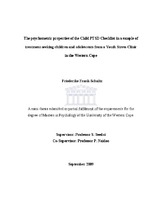| dc.description.abstract | Exposure to severe trauma and resulting PTSD affects individuals of all ages, cultures and geographical areas. Epidemiological surveys reveal that approximately one third of the general population is exposed to a traumatic event at some point in their lives. From the people exposed to a traumatic event about 10% will develop PTSD. Compelling evidence further suggests that the PTSD prevalence in South Africa is even higher,especially among the youth, and has thus been identified as a significant public health concern. In order to adequately address the diverse effects of PTSD,reliable and valid instruments diagnosing PTSD are required. It is a further imperative that these instruments are adapted to the specific context in which they will be utilized. This study thus focused on assessing the psychometric properties (factorial validity and internal consistency) of the Child PTSD Checklist in a sample of treatment-seeking children adolescents in the Western Cape. For the purpose of this study secondary data from a larger, longitudinal study investigating PTSD in children and adolescents was utilized.The preliminary study employed a quantitative research design in order to obtain data from the participants. The sample comprised of 200 children and adolescents between the ages of 8 and 18 years that were selected from the Youth Stress Clinic. In terms of the psychometric properties the scale demonstrated excellent internal consistency(Cronbach’s alpha = 0.93). Exploratory factor analysis revealed a three factor structure(anxiety and avoidance, anger and dissociation, depressive symptoms) which accounted for 41,96 % of the total variance. In conclusion, the Child PTSD Checklist appears to be a promising tool for assessing PTSD in trauma-exposed youth in clinic settings, however further studies are needed to address its broader utility. | en_US |

